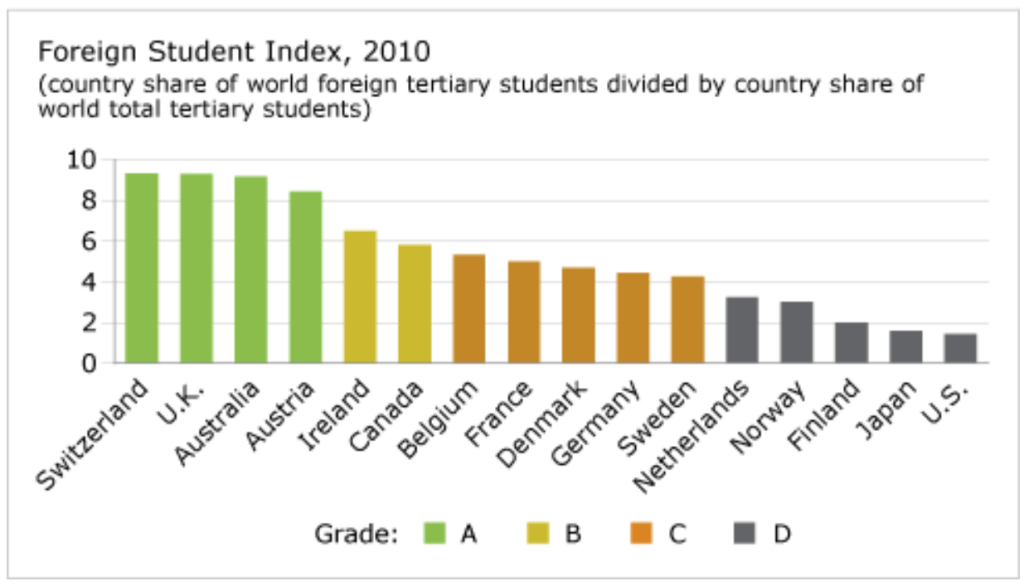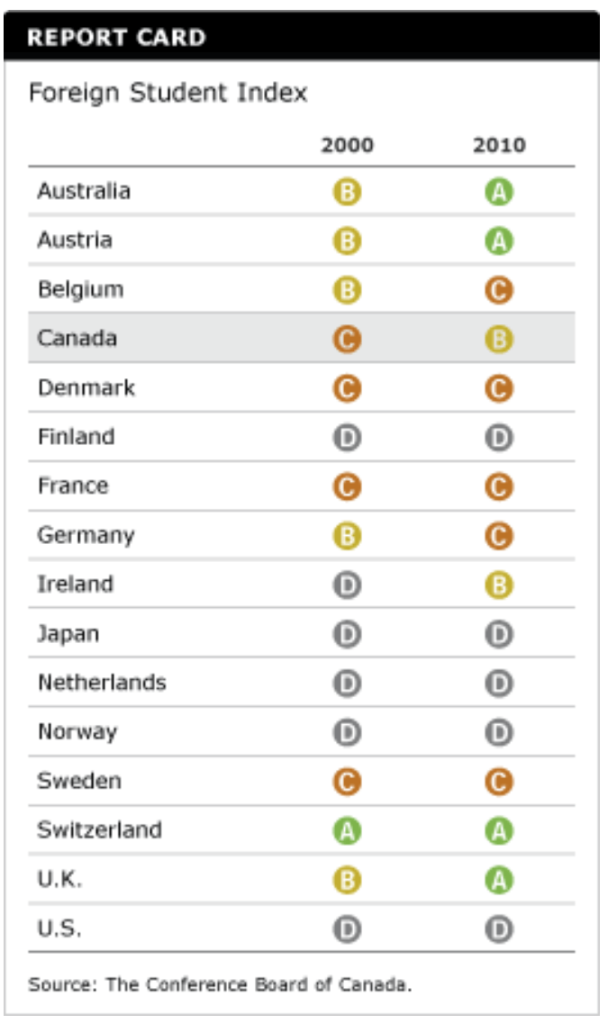Foreign Student Index
Key Messages
- Canada gets a “B” and ranks 6th of 16 peer countries.
- Canada attracts more foreign students than the size of its education system would predict.
- There are good reasons for Canada to improve the attractiveness of its system to foreign students.

Putting Canada’s foreign student index in context
Most assessments of higher education systems tend to examine performance against a set of objective indicators and compare the results across jurisdictions. Further insights can be gained by looking at how attractive the system is to prospective international students relative to their options in other countries. We developed a “foreign student index” that represents a country’s share of the world’s foreign tertiary students divided by that same country’s share of the world’s total tertiary students—that is, a measure of a country’s share of the global market for higher education adjusted to account for the relative size of its higher education system.
How does Canada’s foreign student index compare to those of its peer countries?
Canada achieves a score of 5.83 on the foreign student index—just enough to earn a grade of “B” and rank 6th of 16 peer countries. Canada attracts 4.75 per cent of the total number of students studying outside the country where they hold citizenship. Yet Canada has only 0.8 per cent of the world’s tertiary students. This means that Canada attracts more foreign students than the size of its education system would predict.
However, Canada’s foreign student index is well behind world leaders Switzerland (9.35), the U.K. (9.30), Australia (9.17), and Austria (8.4). To be fair, Switzerland’s performance on the foreign student index is helped a great deal by the fact that its higher education system is very small by international standards. Indeed, it attracts a much smaller number of foreign students than Canada, but scores well by hitting above its weight. By contrast, the U.K. and Australia outperform Canada by attracting more foreign students in both absolute and relative terms—and by wide margins.
Despite its reputation as a global magnet for foreign students, the U.S. achieves a foreign student index score of only 1.45 and ranks last among all peer countries. To be sure, the U.S. attracts more foreign students than any other country—its 16.6 per cent share of all foreign students far exceeds the shares of other countries. But because the U.S. tertiary education system is so large (accounting for 11.5 per cent of all tertiary students worldwide), when we assess its performance relative to size, we find that the U.S. system is hitting below its weight.
By contrast, the U.K.—which also has a strong reputation as a destination for foreign students—has the second-largest share of foreign students (13 per cent) but a tertiary education system that is more than eight times smaller than the U.S. system (accounting for 1.4 per cent of all tertiary students worldwide). In short, the U.K. scores high on the foreign student index because it hits well above its weight in attracting foreign students to its high-quality, but modest-sized, tertiary education system.
How has Canada’s foreign student index changed over time?

The good news for Canada is that it performs much better on the foreign student index than it did a decade ago. Between 2000 and 2010, Canada’s score on the foreign student index climbed from 3.73 to 5.83 and, in doing so, improved from a “C” to a “B” grade.
However, although Canada increased its share of foreign students from 4.6 to 4.7 per cent—which contributed some improvement to its foreign student index score—the full story is that Canada’s score improved primarily because its relative share of all tertiary students dropped from 1.2 to 0.8 per cent. In other words, Canada’s performance looks better because it managed to hold the line on its share of foreign students while the total number of foreign tertiary students worldwide doubled from just over 2 million to 4.1 million.
Still, during the same period, the U.S. foreign student index score dropped from 1.7 to 1.45; this was due in large part to a significant decline in its share of foreign students, from 22.9 to 16.6 per cent.
Which countries perform the best on the foreign student index?
Switzerland ranks 1st among 16 peer countries on the foreign student index, though its lead over Australia and the U.K. has dwindled since 2000. Australia, in particular, has made enormous strides over the past 10 years on the foreign student index—improvements that have been driven almost entirely by an impressive increase in its share of foreign students from 5.1 to 6.6 per cent. Also, although Ireland ranks 5th, its performance on the foreign student index over the past decade has been remarkable. In 2000, Ireland held 0.36 per cent share of foreign students and achieved a foreign student index score of only 2.2. By 2010, Ireland managed to nearly double its share to 0.7 per cent and increase its foreign student index score to 6.5—enough to move it from a “D” to a “B” and rise from 11th to 5th in the rankings.
As a measure of the attractiveness of higher education systems, then, the foreign student index shows that Switzerland, Australia, and the U.K. have reputations for high-quality tertiary education, while Canada is improving but still in the middle of the pack.
The Australian experience provides timely lessons about how aggressive countries should be in trying to attract more foreign students. By 2008, international student tuition accounted for 15 per cent of university funding in Australia—the result of its ambitious recruitment strategy.1 But when the economic crisis hit, the supply of foreign students declined, leaving Australian universities with major funding challenges. Combined with less-than-ideal experiences for some international students, the Australians’ aggressive marketing approach has caused some damage to its universities’ international reputations.2
Still, given the additional benefits of having more foreign students—such as greater diversity in the student body and revenues from foreign students and technology transfers that can help offset declining public financial support for higher education3—there are good reasons for Canada to improve the attractiveness of its system to foreign students. So long as efforts are strategic and gradual, there is much that Canada can do to improve.
Footnotes
1 Jonathan Jenkins, “Critics See Downside to Courting Foreign Students,” Toronto Sun, March 9, 2010.
2 Peter Cebon, “A Lesson in Courting Foreign Students,” Globe and Mail, March 9, 2010.
3 Glen Hodgson and Ben Tomlin, Opportunity Begins at Home: Enhancing Canadian Commercial Services Exports (Ottawa: The Conference Board of Canada, 2006), 11.

